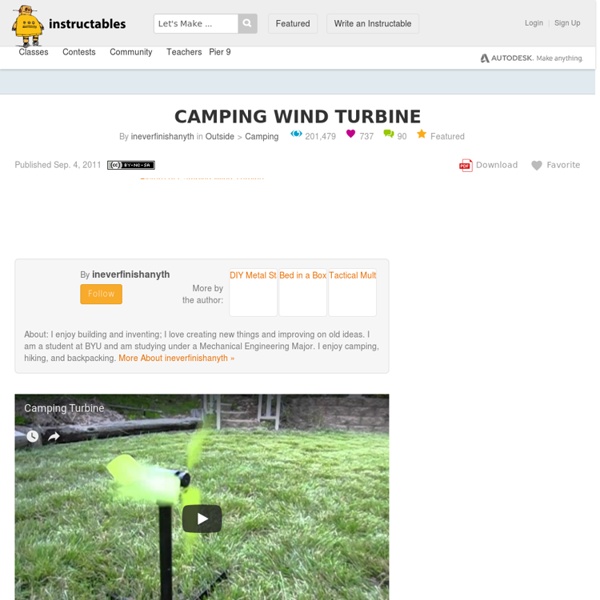Camping Wind Turbine

Yurt Buildng - StumbleUpon
Here is a free copy of my book Build your own yurt, written in 1995, It has been used by a great many people who have built their own yurts. Our designs have progressed enormously since 1995. For a much more comprehensive guide see The Complete Yurt Handbook or see the rest of our website A complete guide to making a Mongolian Ger by P.R. King First edition 1995, Second edition 1997. Third Edition Fully revised and expanded for 1998 Internet Edition Jan 2000 The Yurt The English word Yurt comes from the Russian Yurta describing a circular trellis walled framed tent. The Kirgiz yurt with bent-wood roof poles and crown and a domed overall shape. The two tiered yurt with a pointed roof and two layers of wall section placed one on top of the other. The Mongol or Kalmuk ger with straight roof poles, a heavy timber crown, often supported by two upright poles, and fitted with a wooden door. This proven design is equally well suited to the many uses for moveable dwellings in this country.
Chalkboard Wall Calendar - Martha Stewart Home & Garden
Thanks to paint that dries into a chalkboard finish, your board can be whatever size you desire and placed wherever you like. Store-bought formulas come in traditional green and black. But you can also follow our recipe to mix your own batch in any shade. Tip: Start with flat-finish latex paint in any shade. Wall Calendar A home office is the ideal spot for a family planner. Mudroom Mural The bottom half of a mudroom wall is just the right height for pint-size Picassos -- when coated with store-bought green chalkboard paint. Message Center Write-on paint needn't be applied only to walls. Pantry Reminder Covered with chalkboard paint, a pantry door serves as the perfect place to keep a running shopping list.
Language of flowers
The language of flowers, sometimes called floriography, is a means of cryptological communication through the use or arrangement of flowers. Meaning has been attributed to flowers for thousands of years, and some form of floriography has been practiced in traditional cultures throughout Europe, Asia, and the Middle East. Plants and flowers are used as symbols in the Hebrew Bible — particularly of love and lovers in the Song of Songs,[1] as an emblem for the Israelite people[2] and for the coming Messiah[3] — and of Jesus Christ in the New Testament.[4] In Western Culture, William Shakespeare ascribed emblematic meanings to flowers, especially in Hamlet, Prince of Denmark. Interest in floriography soared in Victorian England and in the United States during the 19th century. History[edit] Floriography was popularized in France about 1810–1850, while in Britain it was popular during the Victorian age (roughly 1820–1880), and in the United States about 1830–1850. Meanings[edit] See also[edit]
Related:
Related:



